Topics:
Content MarketingSubscribe now and get the latest podcast releases delivered straight to your inbox.
What would you do for the secret to doubling your blog traffic and leads?
While you might be willing to pay an arm and a leg, the secret to more traffic and engagement is easier than you think.
You’ve probably seen all of the stats about how blogging for business can improve close rates and increase the number of indexed pages, so I won’t bore you with more, but instead, let’s think about this question: How much of your website traffic is coming from articles that are older than six months? Is this content you would be happy about people discovering today?
To drastically improve the number of monthly leads and increase organic search, you’ll need to factor historical optimization into your content marketing strategy. By implementing this tactic, HubSpot was able to increase the conversion rates on its posts by an average of 106%.
Wait… what is historical optimization? According to HubSpot:
“Historical optimization means updating and optimizing your ‘old’ blog content so it’s fresh, up-to-date, and has the ability to generate even more traffic and conversions than it already does. By ‘old,’ we mean posts that already exist on your blog — whether you wrote them last month or three years ago.”
Not only is historical blog optimization a way to get more out of the content you already have, it’s also a way to get a leg up on such a competitive landscape by keeping your content evergreen and delivering even more value to the people reading it.
This tactic is so effective simply because the content has been indexed for much longer and already has some authority in Google, which in turn will make it easier for your optimized post to gain traction and start moving up the ranks.
Before you start updating random articles, though, you should take a strategic approach to get the biggest impact and identify critical articles to optimize.
How to identify which articles to optimize
When it comes to optimizing your past articles, I always recommend focusing on four core areas:
- Low-converting articles
- High bounce rate articles
- Highly-indexed, low-clicked articles from the Search Engine Results Page (SERP)
- Page one ranking opportunity articles
These articles are going to provide you with the biggest opportunities to increase your traffic, improve your user experience, and increase your conversions.
1. Low-converting articles
You spend so much time, effort, and money creating quality blog articles. Ideally, you’re getting a ton of traffic to your site because of it. More times than not, though, I hear from clients how unhappy and dissatisfied they are in the conversion rate from their articles. Traffic is great, but we need people to contact you and get in your sales pipeline.
By focusing on low converting articles, you’ll be able to make small updates that can help drive big results.
How to identify low converting articles in HubSpot analytics:
- Go to your Reports > Analytics Tools > Website Analytics
- Update the Data Range to be for at least the past 30 days
- Filter Page types by “Blog Posts”
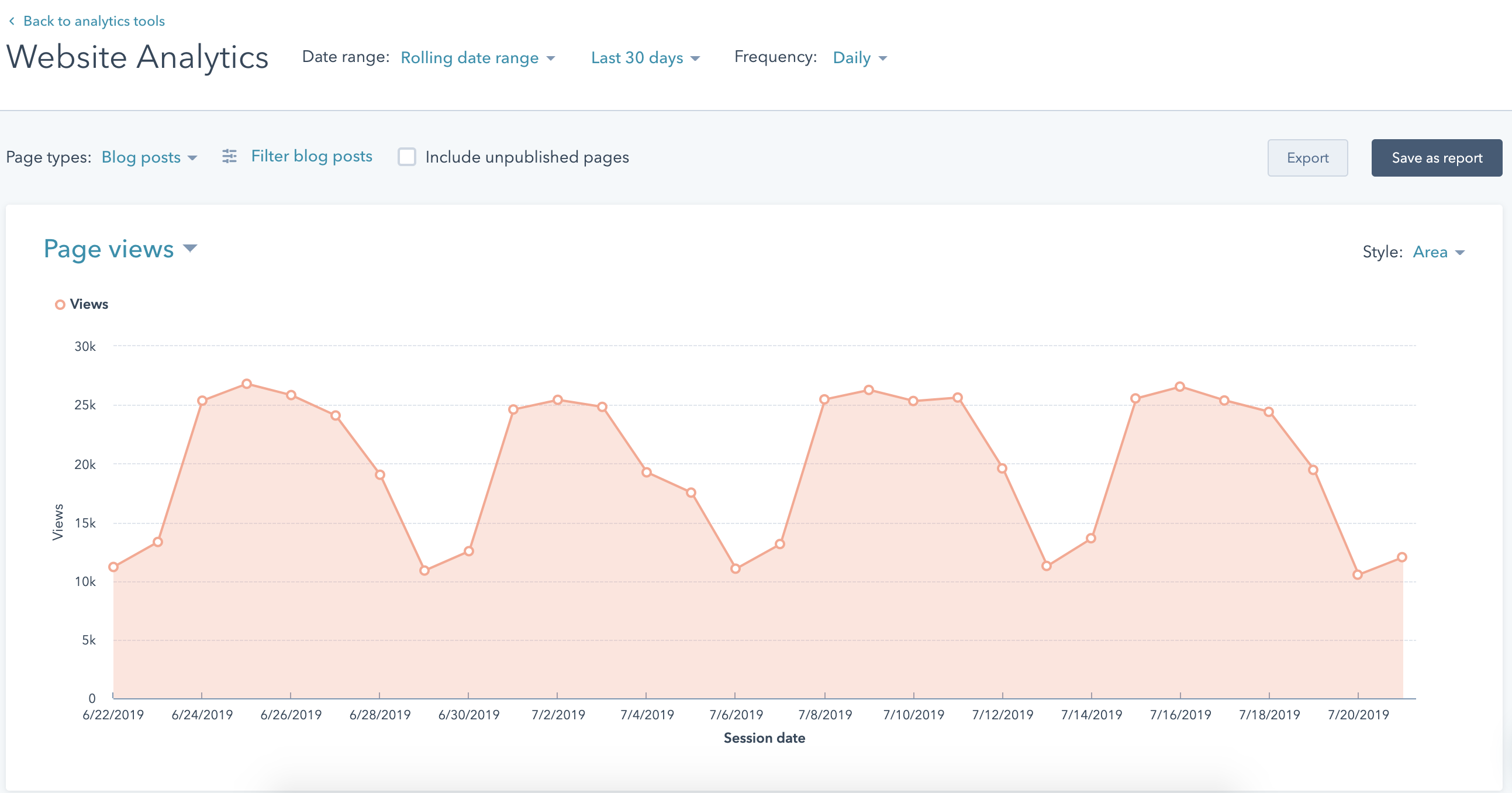
- Click “Export”
- Open your export document and sort by “Raw Views” column in descending order (from greatest to least)
- Remove any articles that have been published in the last six months; you can sort this with the “Published Timestamp” column
- Highlight any rows in the “Submissions Per Pageview” column that is less than 1% — these are your lowest converting articles!
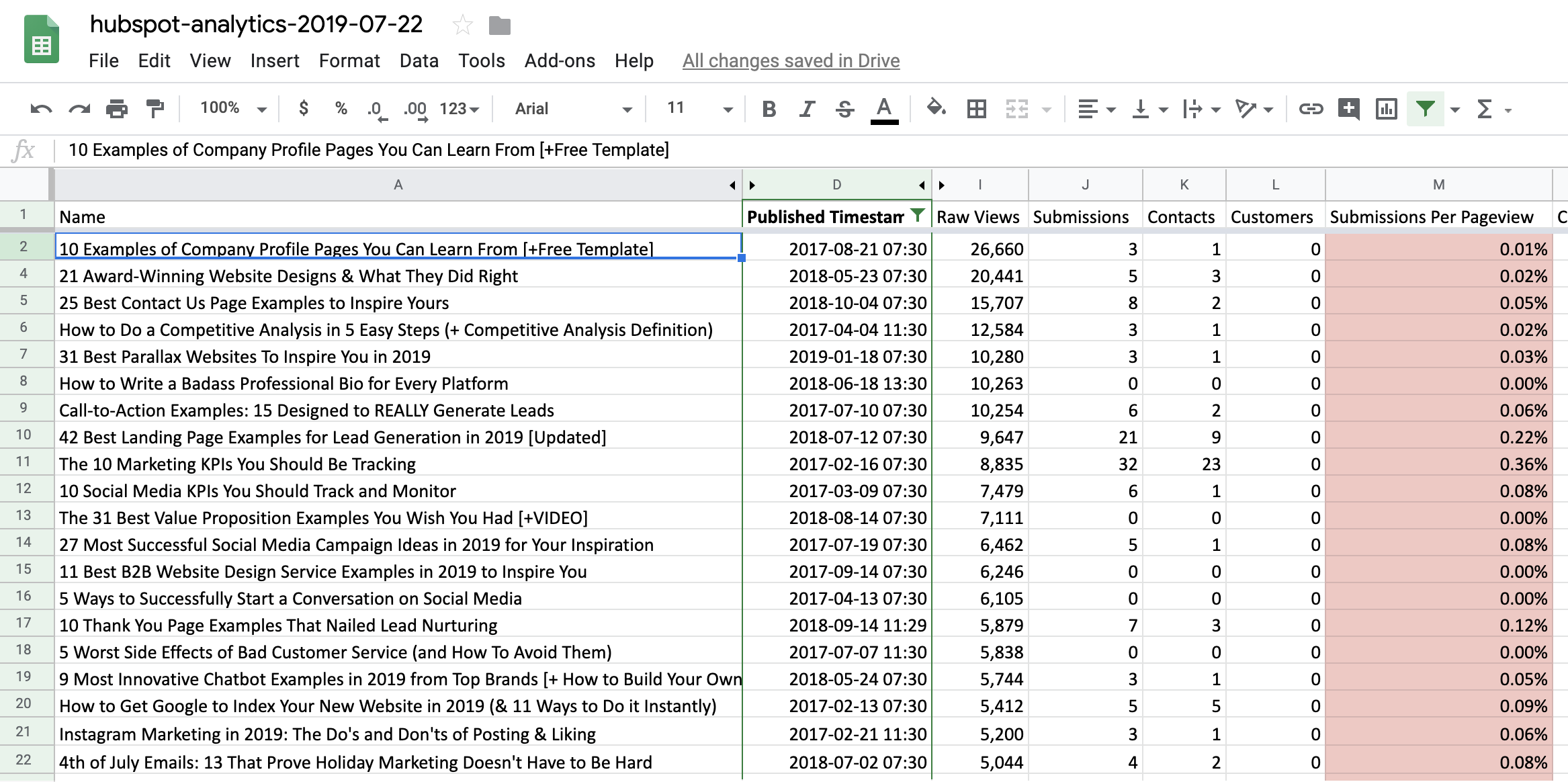
Analyzing the data you pulled in the steps above, begin with the first ten highlighted articles at the top of your report. These are the articles that have the highest views or traffic but are not converting well.
- Analyze the current offer in the article: Is it relevant? Is it outdated? Is there currently no offer included?
- Determine a new offer that is a good next step for a reader to take in each article
- Update the article content to include links and calls to action to the newly identified or updated offer
These steps will provide a better conversion opportunity to the user, increasing the article’s overall conversion rate.
2. High bounce rate articles
Having a higher bounce rate with your blog articles than your website pages is common because most people are looking to find specific educational information and, once they have read it, they tend to leave your site. But that doesn’t mean you settle for high bounce rates from your articles!
How to identify high bounce rate articles in HubSpot analytics:
- Go to your Reports > Analytics Tools > Website Analytics
- Update the Data Range to be for at least the past 90 days
- Filter Page types by “Blog Posts”
- Click “Export”
- Open your exported document and sort by “Raw Views” column in descending order (from greatest to least)
- Highlight any rows in the column that are more than 85% in the “Bounce rate” column
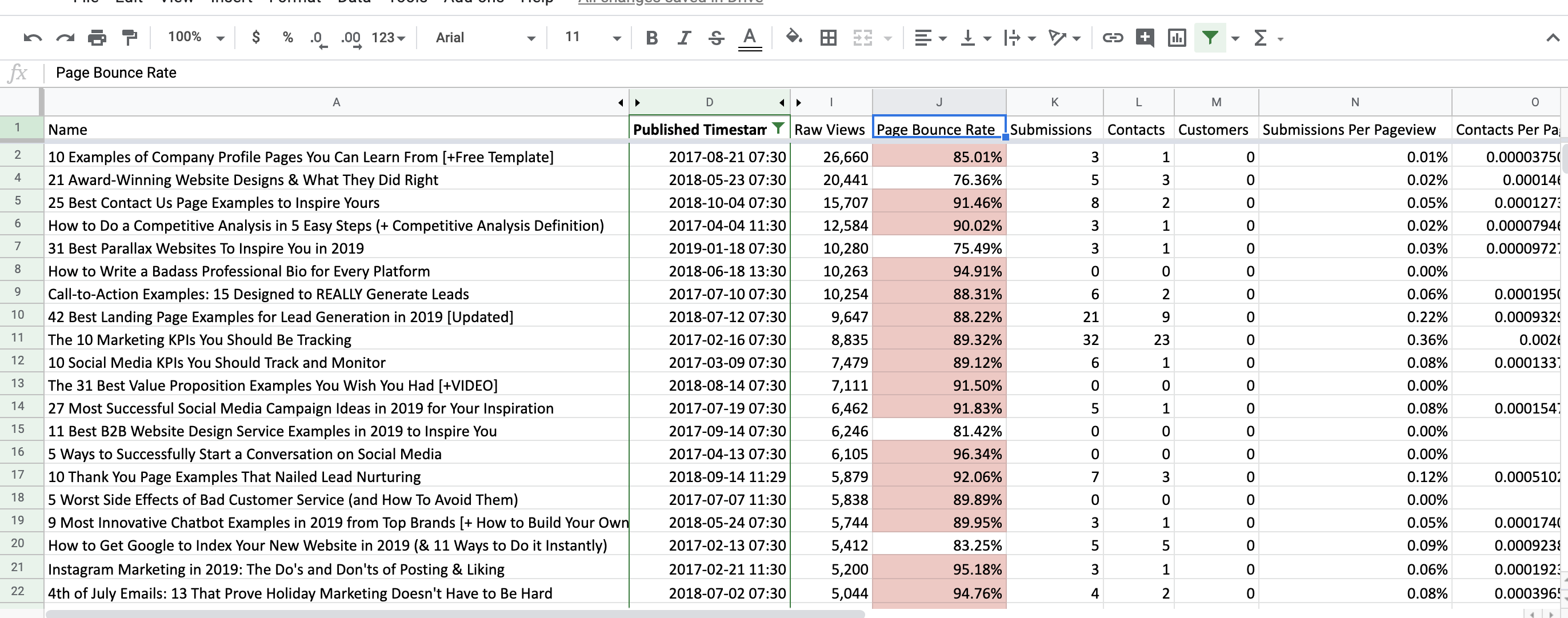
Using your report from above, begin with the first ten highlighted articles from the top. These are the articles that have the highest bounce rates.
- Analyze the hyperlinks in the articles: Are you missing links to internal pages or related articles? Are there better linking opportunities to drive users to better content?
- Analyze the current offer in the article: Is it relevant? Is it outdated? Is there currently no offer included?
- Determine a new offer that is a good next step for a reader to take in each article
- Update the article content to include links and calls to action to the newly identified or updated offer
These steps will encourage the user to click through to another page, thus lowering your bounce rate.
3. High-indexed, low-clicked articles
Articles that receive a significant number of impressions in search engines but not a lot of clicks through to your site is a perfect optimization opportunity to dramatically increase your traffic. By making some minimal tweaks to page titles and meta descriptions, you can encourage more searchers to click through to your site.
How to identify high indexed, low clicked articles in Google Search Console:
- Go to Performance (or Search Results depending on your GSC version)
- Update Date range filter to show at least the last three months
- Scroll down and select “Pages” and update the Rows per page to “500”
- Select “Export Data” icon
- Filter your Page column to only show blog articles
- Sort the data by “Impressions” column, descending order (from greatest to least)
- Highlight data in the “CTR” column that is less than 5%
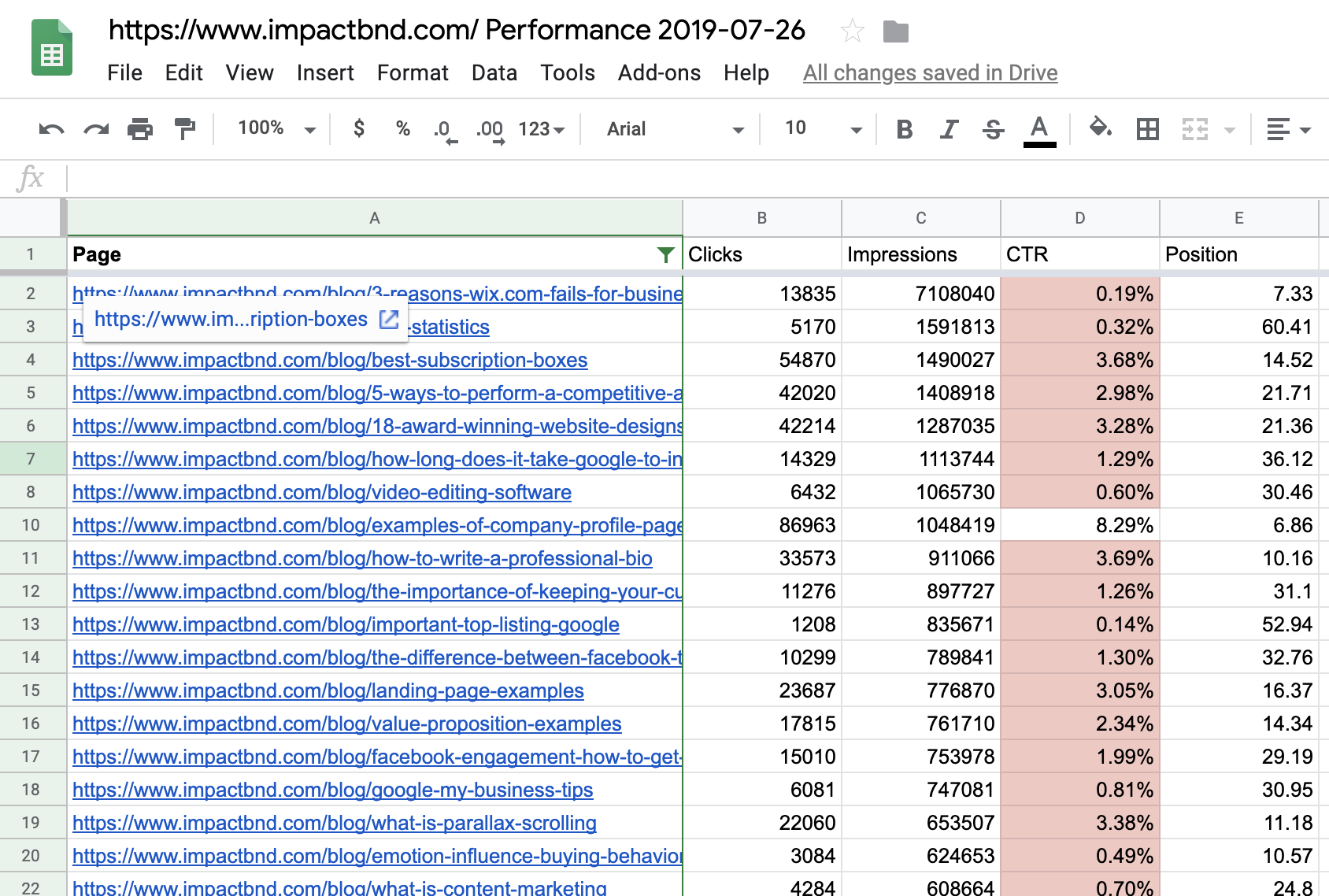
Using your report from above, begin with the first 25 highlighted articles from the top. These are the articles that have the highest impressions on Google but low click through — meaning the articles are appearing in Google’s search result page but people are not clicking through to your site.
- Analyze the Title and Meta Description of each article. Do they each contain a primary keyword that has a high search volume?
- Update the Title and Meta Description to better align with what searchers are looking for (Psst: If you don’t know what your searchers are looking for, ask your sales and customer-facing team for a list of common questions and use your on-page SEO skills.)
- Do not change the publish date; you will only change the publish date of an article if a significant portion of the content has been updated
Monitor the performance of these articles over time. Does their click-through-rate improve? Note the date when you updated each article and see how it performs during the next quarter.
4. Page one ranking opportunity articles
Ahh, my favorite articles to optimize. These are articles that are currently on pages two or three of Google’s search results. You’re oh-so-close to seeing a big traffic increase if you can improve the content of those articles and get them on page one of the SERP.
How to identify page one ranking opportunity articles in Google Search Console:
- Go to Performance (or Search Results)
- Update Date range filter to show at least the last 3 months
- Scroll down and select “Pages” and update the Rows per page to “500”
- Select “Export Data” icon
- Filter your Page column to only show blog articles
- Highlight data in “Position” column that is between 11-30 in green → these are articles on page two and three of Google search results and where you should start
- Highlight data in “Position” column that is between 3-10 in yellow → these are articles on page one but not in the first two positions and should be a secondary focus!
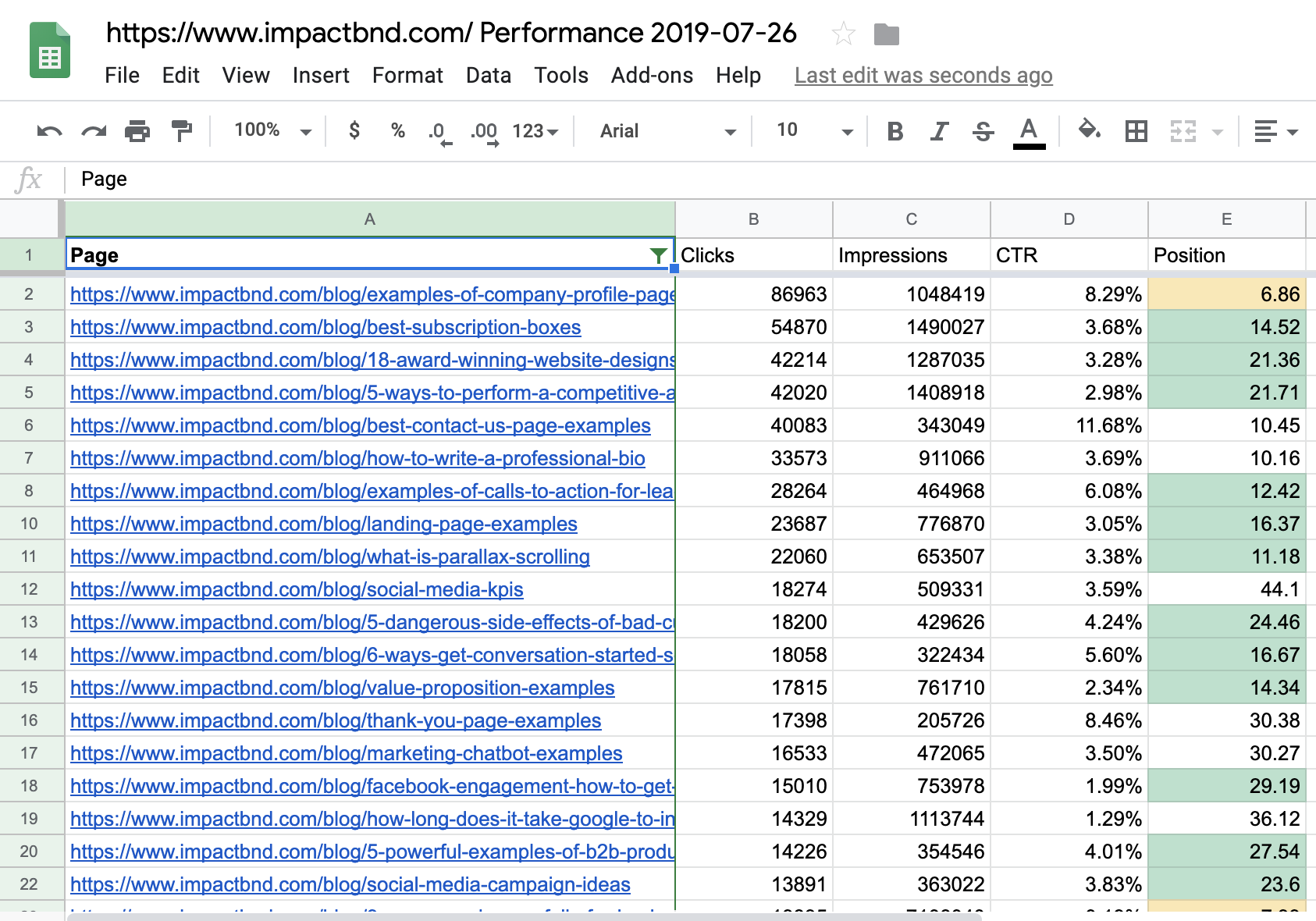
One last time, refer back to the report you pulled in the above steps and begin with the first ten green highlighted articles from the top. These are the articles that have the highest impressions on Google but are on the second and third page of results.
- Analyze content to identify any articles that are outdated, incorrect, or not thorough. These articles will need to be completely rewritten
- Analyze the title and meta description of each article → do they each contain a primary keyword that has a high search volume?
- Update the title and meta description to better align with what searchers are looking for
- Update publish date to be more up-to-date (only if the content has been rewritten or heavily edited)
- Go to Google Search Console > URL Inspection and copy/paste the URL of the article into the search
- Click “Request Indexing” to expedite Google to re-crawl and index the updated article
Remember, any content that is outdated, incorrect, or not thorough needs to be rewritten!
Taking the above steps can have a dramatic affect on your business. Just because an article is underperforming or older doesn’t mean it no longer has value!
Set a reminder in your calendar to review your content’s performance once a quarter. When creating your blog editorial calendar, create a plan to mix historically optimization of older content while continuing to produce quality new content. This will strengthen the health — and SEO — of your website.


Order Your Copy of Marcus Sheridan's New Book — Endless Customers!

